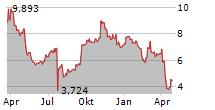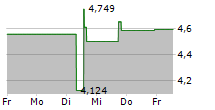New analysis suggests efficacy of Xifaxan to mitigate OHE rehospitalizations irrespective of treatment history
LAVAL, QC / ACCESS Newswire / May 6, 2025 / Bausch Health Companies Inc. (NYSE:BHC)(TSX:BHC), a global, diversified pharmaceutical company, and its gastroenterology (GI) business, Salix Pharmaceuticals ("Salix"), today announced new data showing that people hospitalized due to overt hepatic encephalopathy (OHE) had a reduced risk of OHE-related rehospitalization within 30 days if treated with Xifaxan® (rifaximin) following hospital discharge regardless of prior treatment. These findings, based on a claims-based analysis, will be presented today at Digestive Disease Week® (DDW) 2025 in San Diego, CA.
"This analysis reinforces the use of Xifaxan to help prevent OHE rehospitalizations," said Arun Jesudian, MD, Director of Inpatient Liver Services at NYPH/Weill Cornell. "Cases of chronic liver disease and cirrhosis are growing, and these conditions can be debilitating for patients and their families. Providing patients with optimal, guideline-based treatment regimens is imperative because preventing recurrence and rehospitalizations not only benefits patients but also helps reduce burden on the broader healthcare system."
In patients with cirrhosis, an occurrence of fully symptomatic overt hepatic encephalopathy (OHE) is one of the key complications that defines the decompensated phase of the disease and is associated with worsening outcomes, morbidity, and mortality.1 Because in cirrhosis a damaged liver does not function normally, toxins from the gut can enter the bloodstream and travel to the brain, where they can affect neurotransmission precipitating OHE episodes. These episodes may present as alterations in consciousness, cognition, and behavior.2,3 Up to 80% of patients with cirrhosis will eventually develop some form of HE.1 American Association for the Study of Liver Diseases (AASLD) treatment guidelines recommend the use of Xifaxan as an add-on treatment to lactulose after a breakthrough OHE episode to prevent further OHE recurrence.1
Results of this claims-based analysis showed that patients who received lactulose only upon hospital discharge had a higher risk of 30-day OHE rehospitalization compared to those who received Xifaxan (adjusted OR: 1.63-2.73, p<0.05) regardless of pre-hospitalization treatment. Additionally, the risk of 30-day OHE rehospitalization increased with descending tiers of quality of care (QoC), defined as high-, intermediate- or low-quality based on AASLD guidelines (intermediate vs. high QoC: OR = 1.44, low vs. high QoC: OR = 2.45, all p<0.05). Results remained consistent for Medicare- and Medicaid-insured patients.
"Xifaxan has been proven to effectively reduce the risk of OHE recurrence, so it is concerning to know that some patients leave the hospital without guideline-based treatment recommendations," said Aimee Lenar, Executive Vice President of US Pharma at Bausch Health. "It is vital to recognize hepatic encephalopathy in people with liver disease in the hospital setting and to ensure they have access to high-quality, holistic care upon discharge."
The analysis used claims data from the Komodo Research Data (January 2016 - September 2023) to identify commercially-insured patients with an initial OHE hospitalization. Of the 7,880 OHE patient claims data analyzed, prior to hospitalization, 27.1 percent (n=2,135) were treated with Xifaxan, 24.1 percent with lactulose and 48.8% (n=3,848) received no treatment.
About XIFAXAN
INDICATION
XIFAXAN®?(rifaximin) 550 mg tablets are indicated for the reduction in risk of overt hepatic encephalopathy (OHE) recurrence in adults and for the treatment of irritable bowel syndrome with diarrhea (IBS-D) in adults.
IMPORTANT SAFETY INFORMATION
XIFAXAN is contraindicated in patients with a hypersensitivity to rifaximin, rifamycin antimicrobial agents, or any of the components in XIFAXAN. Hypersensitivity reactions have included exfoliative dermatitis, angioneurotic edema, and anaphylaxis.
Clostridium difficile-associated diarrhea (CDAD) has been reported with use of nearly all antibacterial agents, including XIFAXAN, and may range in severity from mild diarrhea to fatal colitis. If CDAD is suspected or confirmed, ongoing antibiotic use not directed against?C. difficile?may need to be discontinued.
There is an increased systemic exposure in patients with severe (Child-Pugh Class C) hepatic impairment. Caution should be exercised when administering XIFAXAN to these patients.
Caution should be exercised when concomitant use of XIFAXAN and P-glycoprotein (P-gp) and/or OATPs inhibitors is needed. Concomitant administration of cyclosporine, an inhibitor of P-gp and OATPs, significantly increased the systemic exposure of rifaximin. In patients with hepatic impairment, a potential additive effect of reduced metabolism and concomitant P-gp inhibitors may further increase the systemic exposure to rifaximin.
In clinical studies, the most common adverse reactions for XIFAXAN (alone or in combination with lactulose) were:
HE (=10%): Peripheral edema (17%), constipation (16%), nausea (15%), fatigue (14%), insomnia (14%), ascites (13%), dizziness (13%), urinary tract infection (12%), anemia (10%), and pruritus (10%)
IBS-D (=2%): Nausea (3%), ALT increased (2%)
INR changes have been reported in patients receiving rifaximin and warfarin concomitantly. Monitor INR and prothrombin time. Dose adjustment of warfarin may be required.
XIFAXAN may cause fetal harm. Advise pregnant women of the potential risk to a fetus.
To report SUSPECTED ADVERSE REACTIONS, contact Salix Pharmaceuticals at 1-800-321-4576 or FDA at?1-800-FDA-1088 or www.fda.gov/medwatch.
Please click here for full Prescribing Information.
About Bausch Health
Bausch Health Companies Inc. (NYSE: BHC) (TSX: BHC), is a global, diversified pharmaceutical company enriching lives through our relentless drive to deliver better health care outcomes. We develop, manufacture and market a range of products primarily in gastroenterology, hepatology, neurology, dermatology, dentistry, aesthetics, international pharmaceuticals and eye health, through our controlling interest in Bausch + Lomb Corporation. Our ambition is to be a globally integrated healthcare company, trusted and valued by patients, HCPs, employees and investors. Our gastroenterology business, Salix Pharmaceuticals, is one of the largest specialty pharmaceutical businesses in the world and has licensed, developed and marketed innovative products for the treatment of gastrointestinal diseases for more than 30 years. For more information about Salix, visit www.Salix.com and connect with us on Twitter and LinkedIn. For more information about Bausch Health, visit www.bauschhealth.com and connect with us on LinkedIn.
References
Vilstrup H, Amodio P, Bajaj J, et al. Hepatic encephalopathy in chronic liver disease: 2014 practice guideline by the American Association for the Study of Liver Diseases and the European Association for the Study of the Liver. Hepatology. 2014;60(2):715-735. doi:10.1002/hep.27210
Vince AJ, Burridge SM. Ammonia production by intestinal bacteria: the effects of lactose, lactulose and glucose. J Med Microbiol. 1980;13(2):177-191. doi:10.1099/00222615-13-2-177
Khan A, Ayub M, Khan WM. Hyperammonemia is associated with increasing severity of both liver cirrhosis and hepatic encephalopathy. Int J Hepatol. 2016;2016:6741754. doi:10.1155/2016/6741754
###
©2025 Salix Pharmaceuticals or its affiliates.
Investor Contact: |
| MEDIA Contact: |
SOURCE: Bausch Health Companies Inc
View the original press release on ACCESS Newswire:
https://www.accessnewswire.com/newsroom/en/healthcare-and-pharmaceutical/xifaxanr-rifaximin-treatment-following-overt-hepatic-encephalopathy-o-1023754



